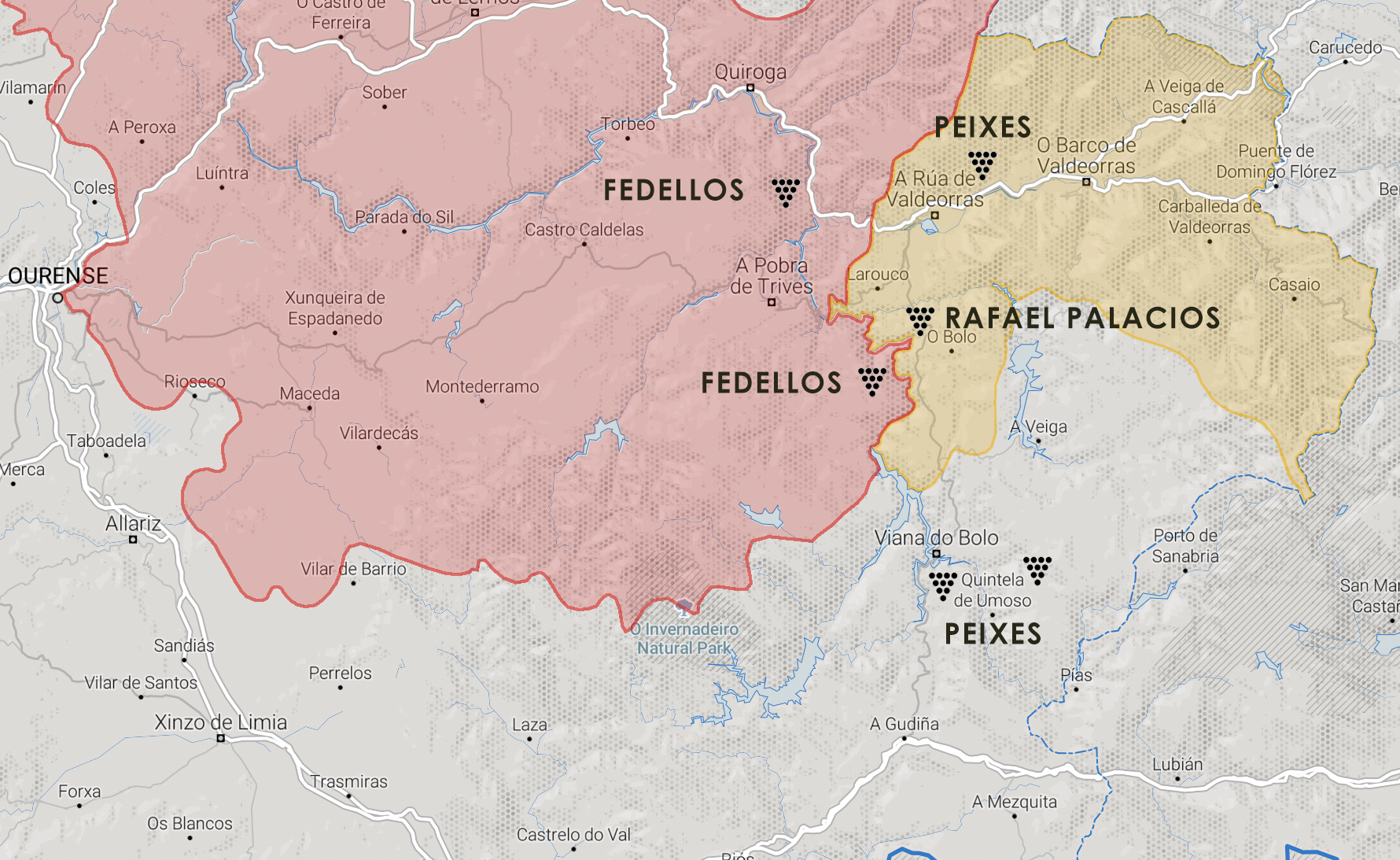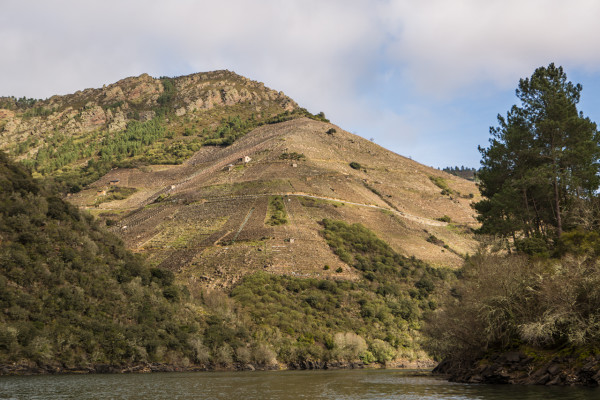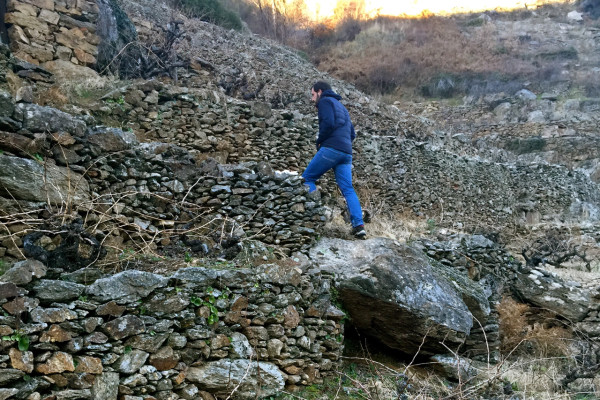


Where in the world are Jesús and Curro? As you can see, they are working vineyards collectively outside any larger appellation and driven by a pursuit of what they find most interesting. We included Rafael Palacios as a reference.
The world is divided into two groups of people, those who divide the world into two groups and those that don’t. If we humor the former, then we might observe that there are rule-followers and those who see rules as a challenge. Jesús Olivares and Curro Barreño are obviously members of the more transgressive party. This isn’t just oppositional defiant behavior, however. While their youthful projects are still expanding and being defined, it is clear that they have a goal – to make the most distinctive and honest expression of single-vineyard and village wines regardless of appellation rules and boundaries.

View of Cortezada from the Ribera do Sil
Jesús and Curro farm three sites that are part of the greater Val do Sil. Within Ribeira Sacra’s borders is their “home” vineyard where they make Fedellos do Couto Cortezada, their pure Mencia from younger vines on a dramatically steep slope – the sort that most people associate with the appellation and pictured above. Further east and within the DO of Valdeorras, they make two wines: Peixes Eixe, a village wine from Córgomo featuring younger vines of Merenzao, Albarello, and Mourantón planted on south-facing slopes of alluvial slate soils, and Peixes Os Bidueiros, a single vineyard wine from 60-year-old vines of Mencia, Garnacha Tintorera, Sumoll, and scattered other varieties all on granitic soils.

Vineyard in the Val do Bibei sub-zone of Ribeira Sacra.
On a call recently, Curro remarked that they are neighbors with Rafael Palacios. In fact, some of their respective sites are separated only by the Bibei river, which at this point is more a meandering mountain stream. The focus at Fedellos do Couto is shifting primarily to this subzone of Ribeira Sacra, where the vineyards are more scattered, sub-divided into tiny plots, and surrounded by forest and scrub. Conasbrancas and Lomba dos Ares are their village wines from this region, and each is a field blend of multiple varieties. They are also actively searching for and adding to their vineyards here with the eventual goal of making a Mencia here to complement the Cortezada and tiny releases of their best sites as single-vineyard wines.

The more open and exposed type of vineyard found in the upper Bibei Valley.
What began as Macizo Ourensan in 2016 has evolved into Peixes in 2018. Originally this project was established to explore the upper reaches of the Bibei river valley, where viticulture remained highly localized and fairly rustic resulting in the region being overlooked when the appellation boundaries were drawn in the early 1990s. However, their work lower down in the valley of the Bibei allowed them the insight to see the potential for their sites around the village of Viana do Bolo. More importantly, since Viana do Bolo was outside any appellation’s boundaries, there was no incentive to replace or replant these older vineyards, and the cost of these vineyards was much more affordable. They also noticed a slight change in the terroir with more pink granite and quartz in the soils. Having left their home appellation in creating this project allowed them to view Ribeira Sacra’s borders as meaningless, so when they had the opportunity to acquire additional vineyards in Valdeorras, it made sense to include them in the Peixes project.
Fedellos do Couto remains Jesús and Curro’s geographically Ribeira Sacra-based project, although none of their wines will carry the DO stamp. This decision was forced on them because their wines were frequently rejected as atypical by the DO tasting panel, which considering the list of others rejected by this esteemed group: Daterra, Envínate, Raúl Peréz, and Sílice, Jesús and Curro are in exceptional company. Peixes will be the project where they can explore the greater region of the Sil and Bibei with sites outside any appellation (as with their vineyards in the upper Bibei valley) and vineyards in Valdeorras, which will be released without any reference to the DO. What unites all of their cuvées is a true commitment to the site- and village-specific wines, which is something we are excited to present to you even if we have to write long explainers to have it all make sense.
Just as we were selling the remaining 2016 vintage, the first round of tariffs impacted the sales of these wines, and since wet weather conditions in 2017 caused a significant reduction in yields due to mildew, we’ve decided to skip it and move on to 2018. So here is a recap provided by Curro of the 2016 vintage, which is largely available in our state-side inventory, and the 2018 vintage, which is available DI.
Late harvest and vintage of contrasts. A mild winter without frosts led to a late bud-break. Rainy spring until June, which led to a delay in flowering. A long and cold cycle that gave us a round maturity, after a cool and humid July that delayed the cycle further but a warm August that led to a healthy harvest without surprises. September ended with a maturation under cold conditions that brought glamorous and opulent wines with a deep expression and loaded with lots of fruit.
Our latest harvest since our very first vintage. This was the vintage of our dreams, even though it was a lot of work in the vineyard due to its abundance of rainfall and its low temperatures. These conditions provided our vines a very long cycle of maturation, giving us perfumed wines of great depth while remaining fresh and vibrant and with a complex expression and texture on the palate. 2018 captures perfectly the differences in landscapes, soils, and varieties precisely in each of our wines. Winter started, then turned very cold after Christmas with a rainy start to spring. This caused a late budding. Spring remained cold and rainy, causing a delay of approximately 3 weeks in the vegetative cycle. The yields in the vineyard decreased a lot. Summer had a cool and rainy start, but then it was dry and very warm until the end.
––
*Fedellos do Couto can be translated as the Brats of Couto, so this is how they refer to themselves.